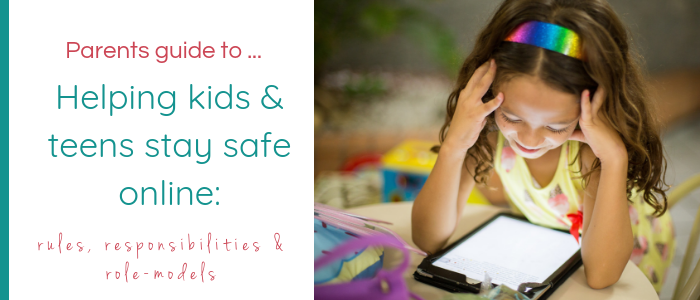Parents guide to helping kids and teens stay safe online: rules, responsibilities and role-models
How often do you pay attention to the terms and conditions before ticking accept when you sign up to a new website or download a new app? The chances are, you glance through at best, or more likely, scroll past to that little checkbox at the very end. If that’s how many of us act online as ‘responsible adults’, how often do children and teens pay attention to what they’re really signing up for?

As part of YoungMinds and The Children’s Society’s inquiry into net safety, they discovered over 60% of young people admitted to having their first social media account by age of 12 – despite guidelines stating they must be 13 or older (with some requiring users be aged 16 or 18). Almost 45% reported spending over three hours on social media alone each day, with 38% admitting what they saw had a negative impact on how they feel about themselves.
Whether we like it or not, children and teens are going online earlier than ever before. Ofcom reported over 50% of children aged 3-4 are regularly going online, while 12-15s spend an average of 18-21 hours each week online or on their phone.
The digital landscape keeps changing. Providing children with the right tools, teaching them the appropriate behaviours, and helping them understand expectations can help keep them safe online, and make sure they know where they can turn if they feel uncomfortable.
With the anonymity going online can provide, combined with typical social pressures children, teens and pre-teens face each day, not to mention with a level of naivety to the consequences of their words or actions, some young people may be more likely to (unintentionally or not) behave in a manner that falls under cyberbullying.
Teaching children about online safety isn’t just about keeping them safe from others; it’s about making sure they know and understand the responsibilities that come with having a social media account, and realise that there are certain behaviours that aren’t acceptable.

Do you know the minimum age requirements to sign-up to some of the most popular social media platforms? According to Ofcom’s 2017 report, only 38% of parents knew the Facebook age requirement. Even fewer could name Instagram (21%), Snapchat (15%) or WhatsApp’s (7%) ages. Discover more about parental controls and age requirements in our parent’s guide to gaming and social media safety.
We share our tips for helping your kids and teens stay safe online.
Be a good role model
 Whether we realise it or not, our children’s relationship with their tablets, phones and social media is often shaped by us, and how they see those around them interacting with their devices.
Whether we realise it or not, our children’s relationship with their tablets, phones and social media is often shaped by us, and how they see those around them interacting with their devices.
Take a moment to sit back and consider how much time you spend each day scrolling through Facebook on your laptop, taking pictures for Instagram or SnapChat on your phone, or watching YouTube on your tablet. How often do you have a conversation at the dinner table with your phone still in your hand or facing up during a meeting?
Phubbing can become a real problem for many of us. How we use our devices teaches our kids what digital engagement looks like, what levels are normal and acceptable, and how it can seem like it’s ok to prioritise our devices over the people around us.
Taking a look at your own social media consumption can be a good first step. Consider how much time you spend, whether your phone, tablet, or console cuts into family time, and if your digital consumption has a mental or emotional impact on you. By managing our own time, using a little more self-discipline with our online engagement, and making sure we respond in healthy ways to what we see and read (rather than allowing knee-jerk reactions to take hold) we can set a better example for kids and teens.
Brush up on privacy settings and parental controls
 Understanding both the concept and importance of privacy can be difficult for some kids and teens. It’s not just the difference from having friends or acquaintances at school seeing what they post online.
Understanding both the concept and importance of privacy can be difficult for some kids and teens. It’s not just the difference from having friends or acquaintances at school seeing what they post online.
Do they understand what could happen when they give out their email address and personal details to get free wi-fi on their tablet when out for coffee or while they’re waiting for you to finish shopping? Do they know how many more people their posts become visible to by using hashtags on social media?
Privacy settings and permissions are so much more than just a tick box – they can have real consequences. Our digital footprint can have a huge, lasting effect in ways they may be too young to realise. Knowing the parental controls available for each device, platform and app can be vital in helping you place restrictions for their safety.
Discuss digital currency
No, we don’t mean bitcoin or ethereum. When it comes to shopping, physical products aren’t the only things we’ve begun buying online. You’ve probably seen stories hitting the headlines countless times already – parents complaining about Xbox charges on their accounts, guardians trying to claim back high bills run up via the app store, and kids assuring that no, they didn’t know they were spending real money on their PC game.
However much you trust your child or teen, avoid linking your card to their game related account. While some kids have reportedly still snuck their parents cards to buy extra in-game points and currency, others have unknowingly run up charges whilst playing.
Sit down and have a frank, thorough conversation about digital currency. It’s important they understand that in-game currency may only be usable online, but if it is costing real money, it can have a real impact for them, you, and the family if they try and buy it without explicit permission. If younger children have trouble understanding, try comparing it to shopping at a toy store or supermarket.
In-game loot boxes have come under fire recently, with some countries going as far as to ban them as ‘addictive’ simulated formed of gambling, often targeted at under-age users. Gaming addiction has in fact now become an officially diagnosable condition, with children as young as nine showing worrying behaviour around certain games.
Although internet addiction is a more established and better known condition, gaming addiction and the potential introduction of gambling behaviours to young people is still being explored. Having these conversations early can help not only highlight what is and isn’t ok for kids and teens to do when it comes to real-life spending online, but it can also help you keep an eye out for any red flags around specific games or apps they may already use that offer these paid options.

Trust, safety, and manipulation
You wouldn’t think twice about having a conversation with your child about stranger danger and where they can go if someone approached them in real life. Applying this same vigilance to online safety can help kids and teens stay safe not only now, but in the future.
Emphasise that they never have to do something someone asks them to online. They don’t need to ‘prove’ anything to friends, classmates, or strangers – whether that’s something they’ve done, who they are, what they are wearing, or things they like.
If they feel pressured to do, share, or say anything from taking photos to talking in an online forum, using their webcam or giving out their contact details for another site, they can say no or leave at any time. Make sure they know who they can talk to if they feel uncomfortable, and highlight other adults they can feel safe talking to if they are embarrassed or would rather not come to you.
The internet is forever
Remind them that there is no such thing as real privacy when it comes to sharing things online. What they say or share one day in a private message to a friend may end up shared for others to see if they have a disagreement or falling out.
Revenge photos can circulate further than friendship groups; accounts do get hacked; passwords are leaked. Once something has been shared, it can be hard to virtually impossible to take it back. A good rule of thumb is if they wouldn’t want their grandparents or parents to see it, they probably shouldn’t share it.
Be prepared by creating a simple set of family rules they can fall back on if they feel uncomfortable encountering one of these situations. Talking these through can help kids and teens feel more prepared, emphasising it’s ok to say no, while giving them a few pre-prepared excuses if they need them.
It may not sound cool, but making sure kids are ready to say no and to shift the focus back to you can help; ‘I can’t, my parents check my accounts’ or ‘I can’t, if I do that I will lose my phone/tablet/computer privileges’ can be good excuses if they feel uncomfortable just saying no if their friends persist.

Discuss the emotional impact
If kids are caught out saying or doing something mean, common fallbacks are often to say ‘it’s just a joke’, ‘I didn’t mean anything by it’ or the old favourite, ‘everyone else was doing it’.
When it comes to things online, it can be even easier to get caught up in mob mentality and forget there are feel people, with real feelings on the other side of the screen that are being talked about, laughed at, made fun of, and whose feelings are getting hurt. It doesn’t matter how many likes, shares, or comments something has; it still might be wrong.
Before they post or share online, get kids to consider:
- Would you say that to someone’s face?
- If someone said that to your best friend, how would you feel? Would you be upset or speak up?
- How would you feel if someone said that to you?
Make it clear they can always come and talk to you or another adult if they feel uncomfortable. Upsetting and bullying behaviours are never ok – whether they are online, at home, or at school. Teach them to approach social media with more empathy and compassion by encouraging them to stop, pause, and think before they post about someone else online, or share something about others.
If they wouldn’t say or do something in person, they shouldn’t do it online. The same applies to seeing others bullying people online; if you would speak up, or seek an adult for help if you say this being said or done at school or to a friend, you should talk to an adult about it and help to put a stop to it.
Setting ground rules (and sticking to them)
Creating your own set of family rules for device usage and supervision can be the best way to find what works for your family. For many, making adult supervision non-negotiable can be the way to go. By insisting you have access to their social media account passwords you can make sure that they are staying safe, but this approach can be a little heavy-handed for some teens.
Whatever approach you settle on, remember to praise good behaviour, and make sure you keep on top of any safety or privacy updates on their favourite social media platforms.
Although many sites have minimum age requirements, make sure you discuss these with your child or teen before they reach that age. Many may sign up early, or be tempted to join without telling you if their friends are already members. By establishing an open, honest dialogue early on, this can help them feel more comfortable coming to you if something does go wrong or if they feel uncomfortable – rather than focusing on worrying they may get in trouble.
Playing an active role in helping children and teens stay safe online is important, but remember: you can’t be there for them every minute of the day. By focusing on instilling safe, thoughtful behaviours around digital and social media, we can help young people discover the best ways they can keep themselves safe.
It’s easy to focus on the potential negatives when it comes to keeping children and teens safe online, but it’s important to remember the positives these platforms can have too. Social media, apps, and websites can:
- Help kids stay connected with friends and family they may not be able to see every day.
- Teach them the importance, impact, and how they can get involved with volunteering, social responsibility projects, campaigns, or raising money for charity.
- Encourage them to embrace and express their creativity through sharing their own or others art, music, writing, or ideas.
- Enable children and teens to connect and make new friends with similar interests.

Find a therapist dealing with Young people's counselling
All therapists are verified professionals





